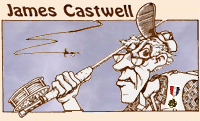|
Over the years fly rods have gotten stiffer. And longer. In the 'old days'
(bamboo) most fly rods were rather short by today's standards. If not,
most were very soft. The invention of fiberglass, and now graphite has
given rod makers the ability to make them not only light in hand, but stiffer,
i.e. fast. In the old days of bamboo, for a rod to be fast (stiff) it had to be very
thick, that made them heavy in hand. For most folks, too heavy to cast
for any length of time. Technology has improved cane as well.
Long rods were soft but with the fast casting silk lines, a balance was struck
and all was well. At about the same time that fiberglass and graphite came
along, the new era of fly lines was born. The new lines did not go as easily
through the guides as silk as they were bigger in diameter and had more
friction with the guides. Also, they were more wind resistant. But the
new rods were faster so a balance was again accomplished. Slower
lines but faster and lighter rods, all was well.
Today we see rods of nine feet casting the new lines very nicely. In the future
you will see refinements in line coatings, rod material, guides and rod design
which will produce rods into the ten and eleven foot range, good rods
designed for a one-hand cast. It is much harder to stop a ten foot rod
than it is a nine foot rod. The mass simply wants to continue in motion.
As rod lengths increase, the weight in hand will stay in the light range,
but the stiffness, power and length will increase. I use a ten foot rod
now and have for a few years. It is great for what I use it for, but there
is no question, it is harder to stop. And stopping the rod is what forms
the loop, both back and front loops. Remember too, it has one more
guide to slow down the line.
On that subject, I still hear folks who should really know better mention
they use nine foot rods for everything, except when float-tubing. There
they use a ten footer to keep the line off the water behind them. Because
a ten foot rod is harder to stop and therefore throws a more open loop
(which will hit the water) than a nine foot rod, why would a person want
to use a longer one under such a condition? Makes no sense whatsoever.
A ten foot rod is most valuable for mending line, after that it's value
diminishes.
Every generation feels they are at the end of development, that anything of
value has been invented and developed. We have come a long way, but,
"it ain't soup yet." Watch for the availability of lighter, longer and faster
rods in the future.

This is not however where the market will go. A ten or eleven foot rod is
too limiting for many situations and will not become the standard in use.
It would be too long for many casting conditions and would be more
difficult to produce a tight loop for most casters. The future will hold
lighter rods. Rods which are easier to stop giving the newer casters the
ability to form more controlled loops with less experience and effort.
The rods will also, in general, be more on the medium-fast to somewhat
less than that. The actions will be more of a progressive action and not
so much concentration on sticks which tend not to flex at any point
on the rod.
Tomorrow's rods will be lighter, from 7 to 9.5 feet, medium-fast to
moderate-fast action and with new technology in guides and fly lines
perform like a dream. If you look real hard, some of them are at
your fly-shops now (or will soon be). ~ James Castwell
|



